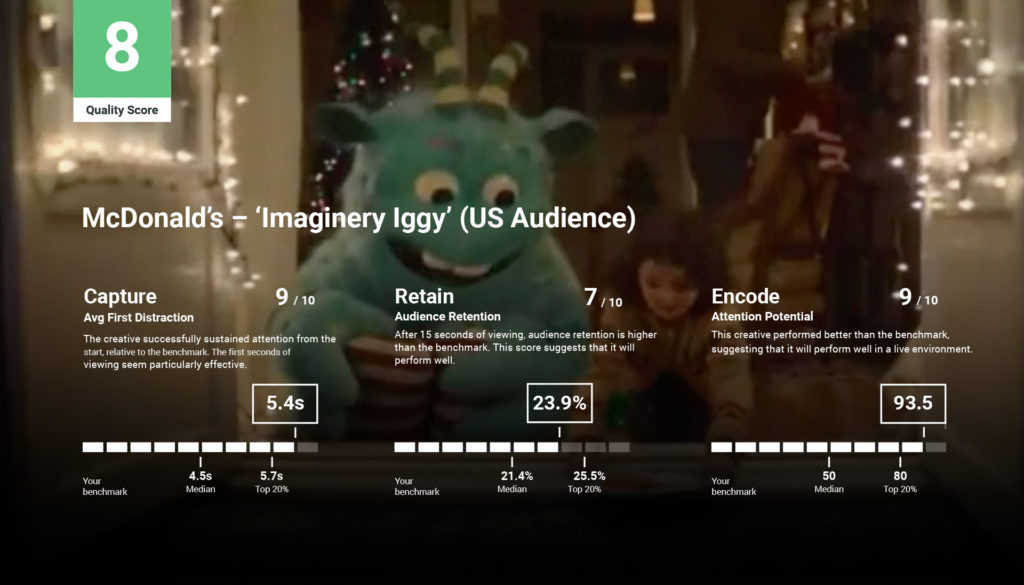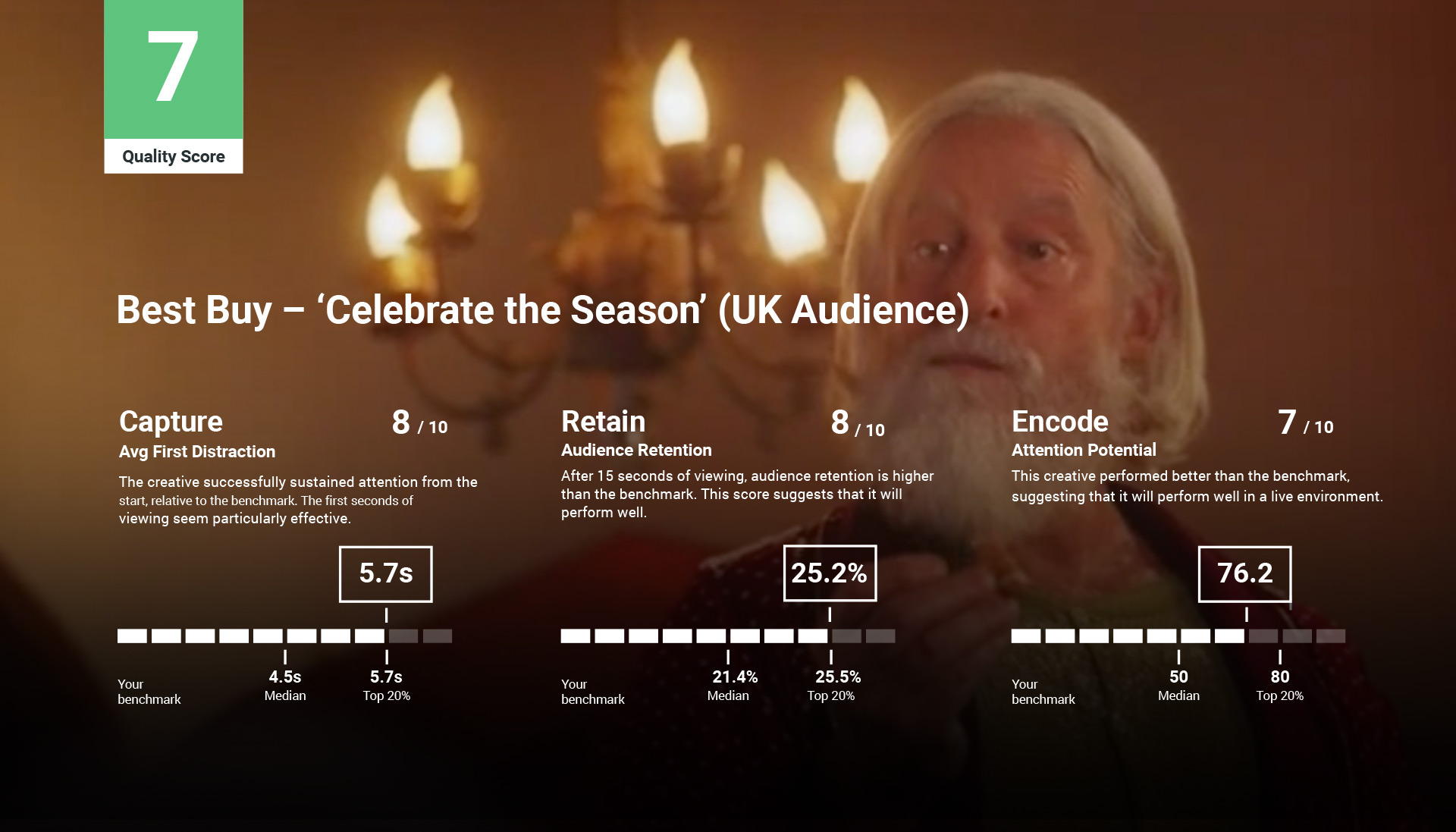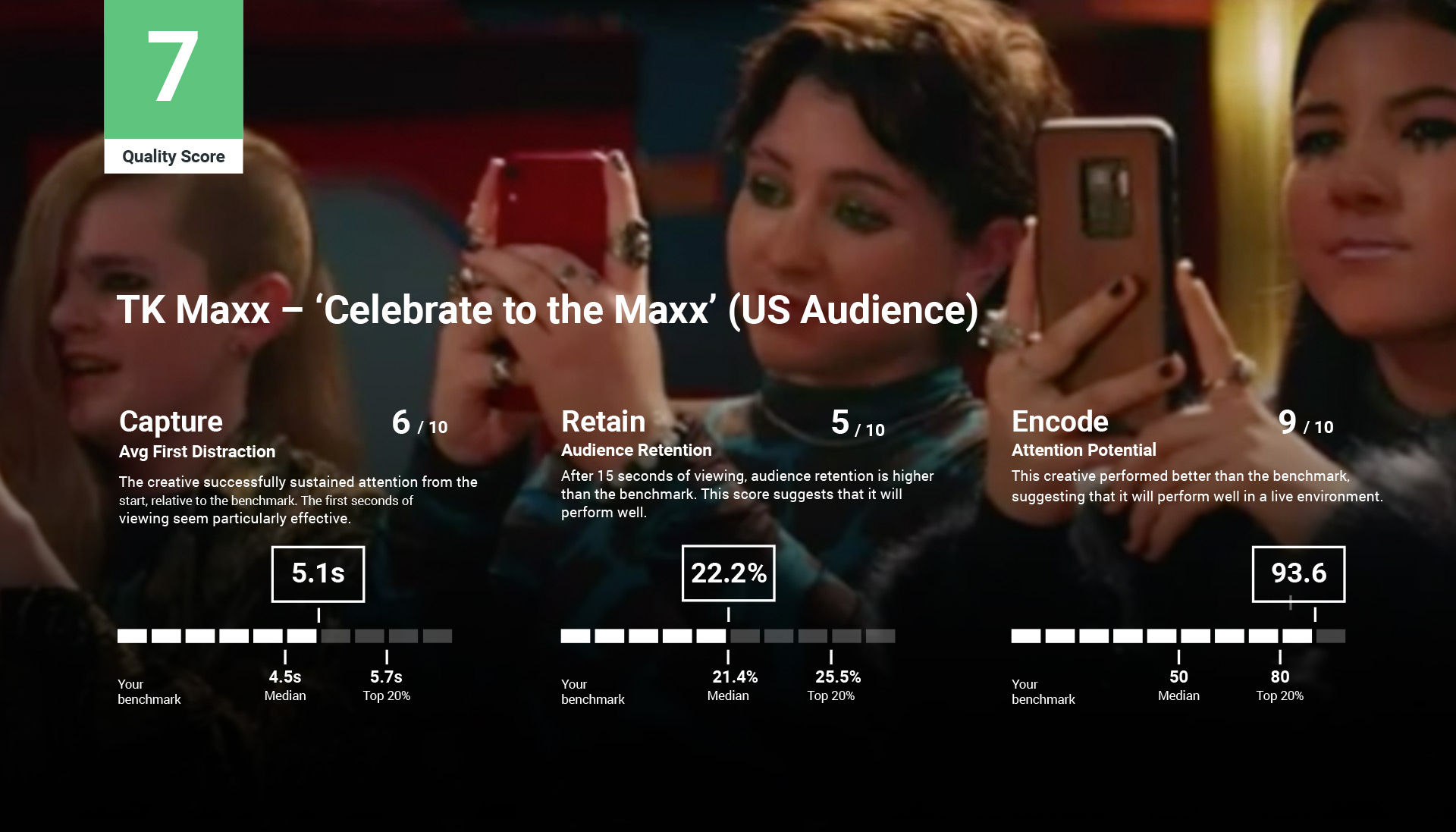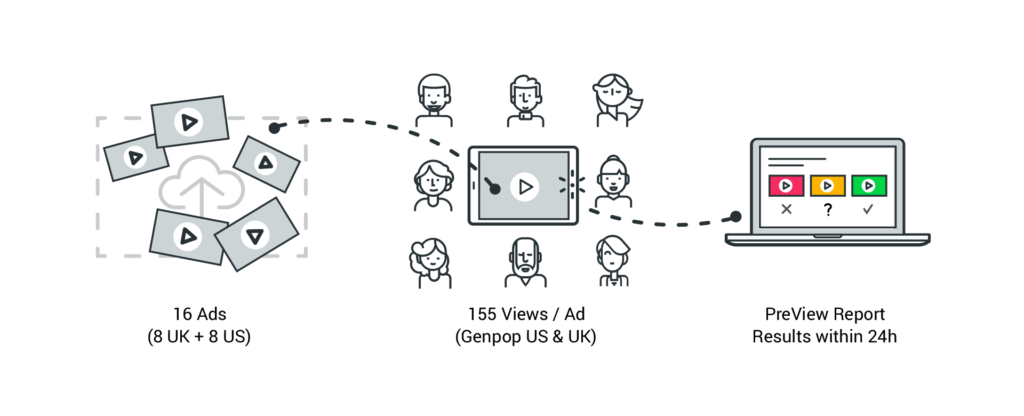An independent study on creative performance and audience attention based on UK & US festive ads Ads, Q4 2021
What You Need to Know
- Americans responded favorably to cinematic, emotionally-driven ads from the United Kingdom, even more so than the UK audience (Quality Scores of 6.1 to 5.9)
- Creating UK-style “cinematic” ads for the US audience has significant economical implications. British ads shown to the American audience had a 23% lower cost for quality exposures for American ads
- Longer cinematic ads must hook attention and emotion early, or they lose their audience before the payoff
- Humor plays well during the holidays; ads that made audiences laugh performed among the best
- American retailers have a huge opportunity to differentiate from the barrage of transactional advertising by leaning into emotional storytelling

Introduction
Two Culturally Different Approaches to Holiday Advertising
British advertisers favor emotionally-driven cinematic ads, while American retailers favor transactional and humorous messaging
While much of the world celebrates the festive holiday season, it is perhaps a more intensive occasion in the UK, where holiday parties, themed sweaters and cinematic advertising are legendary.
UK retailer John Lewis, for example, is famous for creating two-minute-plus epic ads that tug on viewers’ heartstrings. 2021 was no different, as the retailer released the 2:30 “Unexpected Guest” on November 4, depicting a boy who encounters an extraterrestrial who he teaches about Christmas. The ads have become a destination event in the UK since they began releasing them in 2007. Other UK retailers have followed in John Lewis’s footsteps. In 2021, many are releasing cinematic videos with messages meant to create heartfelt emotions.
Such stylistic contrast between US and UK advertising raises the question: Which approach performs better? How might each country’s creative approach resonate with the other country’s viewers? How would UK ads capture attention and drive emotional response in the US, and vice versa? To answer these questions, we selected 16 video ads, including eight from each country, and tested each one in both markets. Where there was a global retailer that had ads in both countries, we tested both ads
Quality Scores
The rows represent which audience viewed the ads and the columns represent where the advertisements were made and for which audience they were intended.
| Audience | UK Ads | US Ads |
|---|---|---|
| UK | 5.9 | 4.8 |
| US | 6.1 | 4.8 |
qCPM
| Audience | UK Ads | US Ads |
|---|---|---|
| UK | $20 | $25 |
| US | $17 | $22 |
Creative Efficiency
| Audience | UK Ads | US Ads |
|---|---|---|
| UK | 58% | 48% |
| US | 62% | 48% |
Such stylistic contrast between US and UK advertising raises the question: Which approach performs better?
Americans Favored Cinematic British Ads Over American Ads Made for Them
Written by Keith O’Brien| Q4 2021
Americans are not just interested in sales and product-themed ads. They paid closer attention to cinematic ads from the UK than they did to the US ads intended for them. The Quality Score for American ads shown to the US audience was 4.8 (out of a possible 10), while the Quality Score for the British ads shown to the same US audience was 6.1. Four of the five highest-scoring ads among the US audience by Quality Score were originally created for UK audiences.
Thus, US retailers should mirror the strategy of John Lewis, the ad of which received a 9 in Quality Score for the US. John Lewis focuses on brand building during the holidays through a heart-warming, cinematic advertising campaign. The company banks significant goodwill that it builds upon through direct response marketing throughout the year.
US audiences may be burned out from years of sales and door-buster ads, yearning for something more unique and story-driven. It also demonstrated that Americans are more receptive to emotionally impactful creative, especially during the holiday season. This represents a big opportunity for US advertisers to stand out from the crowd in their holiday advertising by injecting more narrative versus the obvious hawking of merchandise.
McDonald’s UK “Imaginary Iggy” is a sentimental ad (reminiscent of John Lewis’s 2017 Christmas ad ‘Moz the Monster’) that depicts a girl creating and forgetting an imaginary friend during her journey to adolescence, only to remember him when seeing a young child playing at McDonald’s. While this ad’s heartfelt approach is similar to many other UK ads, it had a Quality Score of 4 in the UK while it received an 8 in the US. And the US Encode scores (an emotional response score ranked from 1-100) were more than double that of the UK (94 to 42).

British Ads Drive Lower Costs for Media Outcomes in US & UK
The opportunity for American advertisers to tap into the attentive power of the British creative approach has significant economical implications. If there were a nominal CPM of $10, the average cost per 1,000 quality exposures (qCPM) for the American-intended ads for the US audience would be $22. That compares to $17 for the British-intended ads with the US audience, a 23% lower cost for quality exposures. That $17 qCPM is even lower than the UK qCPM of $20 for British-created ads intended for them.
Similarly, assuming the same $10 nominal CPM, American ads would have a qCPM of $25 among the UK audience. That compares to $20 for the British-intended ads among the UK audience, a 20% lower cost.
UK Ads Outperformed the US Ads With Both Audiences
On average, both audiences gave the US video creatives a Quality Score of 4.8. The UK did not respond as favorably to the US ads as the US audience responded to the UK ones.
The top five ads for the UK audience were all produced in the UK.
So which US ads did the UK audience like? The humorous US Best Buy ad, “Celebrate the Season,” scored high among the UK audience, which imagined Santa Claus interrupting a party of Elves, even though the ad made much more prominent use of Best Buy logos and product shots than most UK ads. The UK audience responded with a Quality Score of 7 and Encode of 76, versus the US, which had a Quality Score of 4 and Encode Score of 41.

The US 15-Second Ads Performed Better in the UK Than in the US
UK audiences responded more positively to the three 15-second ads, all US-based content. Those ads had a Quality Score of 5.3 in UK audiences and 4.7 for US audiences. All three had a lower qCPM than the $22.49 average qCPM for ads shown to the UK audience.
While the UK creative averaged approximately 90 seconds per ad and the US ads averaged about 40 seconds, the UK audience responded favorably to shorter US ads, and the US audience paid attention during longer UK ads.
While UK retailers should continue to create ads with heart, emotion and humor, they can and should also experiment with shorter forms to tell their stories.
Humor is a Powerful Asset
The UK ads that performed best in the UK market were more absurd or humorous than sentimental.
While the John Lewis ad was intended to produce warm feelings of friendship, it also deployed bits of levity, e.g., when the extraterrestrial and the human boy played tricks on each other. Two other ads with high Quality Scores were UK-created Lidl (8 with the UK audience and 7 with the US audience) and UK-created TK Maxx (7s both among UK and US audiences). Both used humor as the main creative choice: Lidl imagined Christmas in the far future where the tools to cut the turkey get progressively more advanced and TK Maxx leaned into humor as a boy’s new shoes made him a piano-playing superstar.
Advertisers should feel comfortable taking risks in their creative and employ humor, even if they also use more sentimental messages.

Long-Form Creative Can Excel at Retention
Convention wisdom is that people have shorter attention spans and that ads over one minute will lose people’s attention. But we found that of the top five videos by retention percentage, four had a run time of a minute or more. Those that excelled quickly set up the conflict or dramatic stakes, whereas the longer videos with poor retention often took too long to make clear to the viewer the arc of the creative message.
One ad that did not establish a payoff until much later had already lost its entire audience by the 12th second, well before the brand message was established. Compared to the John Lewis ad, which introduced the extraterrestrial early and still had 22% audience retention by the time it introduced a John Lewis shopping bag.

Brand Messaging Can Transcend Regions
For brands that had ads in both markets, the US audience responded much more favorably to the UK versions than the UK audience responded to the US versions. Only the US version of the Amazon ad scored higher in the UK than in the US.
| TK/TJMaxx Ads | Origin | US Audience | UK Audience |
|---|---|---|---|
| Christmas to the Maxx | UK | 7 | 7 |
| HomeGoods 2021 | US | 7 | 2 |
| Amazon Ads | Origin | US Audience | UK Audience |
|---|---|---|---|
| Kindness, the Greatest Gift | UK | 8 | 3 |
| Thoughtful Theo | US | 4 | 6 |
Mandates
US Advertisers Should Employ Cinematic Storytelling for Christmas
While the Super Bowl will remain the destination advertising event in the near future, the holidays are a great opportunity for more meaningful brand building. It is not only more economical, but you can tap into that affinity throughout the year.
Balance Brand Storytelling With Performance Messaging
Brands in both countries should expand beyond their comfort zone to try new creative directions. US advertisers can lean into more cinematic advertising, and UK brands should try shorter, more product-oriented holiday campaigns. Brands that use narrative storytelling during the holidays can build long-term equity, influencing sales throughout the year.
Lean Into Humor
Ads that used humor did well across creative and audiences. While many associate the holidays with warm emotions, people also want to laugh and have fun. More brands should lean into humor to drive greater attention and emotional response.
Multi-Country Advertisers Should Cross-Test Ads in Different Markets
While an ad created for a specific market is more likely to appeal to that audience, this study found that certain UK ads performed better with US marketers and vice versa. As always, pre-testing creative is a great way to ensure you don’t miss a huge opportunity to leverage a new market for existing content. Global brands can either use high-performing creative in multiple marketers, or use the foundation of those ads to build similar ads (with slight alterations as necessary) for multiple markets
Long-form Ads Need to Set the Dramatic Arc Immediately
Consumers are willing to watch long-form ads and will pay attention, but only if you establish the foundation of the ad immediately. Ads that are unclear after a few seconds will lose most, if not, all of your audience.
US Audiences
| Brand | Creative | Origin | Duration | Quality Score | Capture | Retain | Encode | Efficiency | qCPM | |||||
|---|---|---|---|---|---|---|---|---|---|---|---|---|---|---|
| McDonald's | Imaginary Iggy | UK | 01:30 |
8 |
5.4 | 23.9% | 93.5 | 80.2% | $12.5 | |||||
| Amazon | Kindness, the Greatest Gift | UK | 02:30 |
8 |
5.3 | 28.2% | 72.1 | 80.4% | $12.4 | |||||
| TK Maxx | Christmas to the Maxx | UK | 01:55 |
7 |
5.1 | 22.2% | 93.6 | 66.9% | $14.9 | |||||
| TJ Maxx | HomeGoods 2021 Holiday Commercial | US | 01:00 |
7 |
5.5 | 22.6% | 95.1 | 66.2% | $15.1 | |||||
| Lidl | Big on a Christmas You Can... | UK | 01:00 |
7 |
4.8 | 22.6% | 95.1 | 66.2% | $15.1 | |||||
| Korger | Holiday Recipes | US | 00:30 |
6 |
5.5 | 23% | 52.9 | 62.2% | $16.1 | |||||
| very.co.uk | It's the Very Best Excuse | UK | 00:30 |
5 |
4.6 | 47% | 76.1 | 67% | $15.01 | |||||
| M&S Food | Percy Pig Comes to Life | UK | 01:10 |
5 |
4.4 | 20% | 75.5 | 49.9% | $20.0 | |||||
| John Lewis | Unexpected Guest | UK | 02:00 |
5 |
3.9 | 18% | 93.4 | 46.9% | $21.32 | |||||
| Walgreens | It's Walgreens Season | US | 00:15 |
5 |
3.9 | 13% | 96.4 | 45.5% | $21.97 | |||||
| Walmart | Black Friday Deals | US | 00:15 |
5 |
4.6 | 20% | 51.3 | 46% | $21.72 | |||||
| Best Buy | Celebrate the season | US | 01:00 |
4 |
4.2 | 24% | 41.3 | 47.4% | $21.08 | |||||
| Macy's | Tiptoe and the Flying Machine | US | 01:30 |
4 |
5.3 | 0% | 49.2 | 30.4% | $32.68 | |||||
| Amazon | Thoughtful Theo | US | 00:15 |
4 |
3.9 | 18% | 88.0 | 46.1% | $21.69 | |||||
| Barbour | Paddington, Please Look After This.. | UK | 01:36 |
4 |
3.5 | 17% | 94.0 | 43.1% | $23.20 | |||||
| Target | The Holidays are Meant to Be Shared | US | 00:30 |
3 |
3.9 | 22% | 27.0 | 40.1% | $24.94 | |||||
| Average |
5.4 |
4.6 | 19.9% | 71.5 | 54.6% | $19.54 | ||||||||
UK Audience
| Brand | Creative | Origin | Duration | Quality Score | Capture | Retain | Encode | Efficiency | qCPM | |||||
|---|---|---|---|---|---|---|---|---|---|---|---|---|---|---|
| John Lewis | Unexpected Guest | UK | 02:00 |
9 |
7.2 | 27.4% | 71.1 | 84.0% | $11.9 | |||||
| Lidl | Big on a Christmas You Can... | UK | 01:00 |
8 |
5.4 | 25.4% | 85.1 | 75.2% | $13.3 | |||||
| Best Buy | Celebrate the Season | US | 01:00 |
7 |
5.7 | 25.2% | 76.2 | 69.4% | $14.4 | |||||
| very.co.uk | It's the Very Best Excuse | UK | 00:30 |
7 |
5.5 | 21.3% | 90.6 | 64.7% | $15.4 | |||||
| TK Maxx | Christmas to the Maxx | UK | 01:55 |
7 |
5.1 | 28.1% | 50.3 | 71.5% | $14.0 | |||||
| Amazon | Thoughtful Theo | US | 00:15 |
6 |
5.1 | 23% | 92.5 | 65.0% | $15.4 | |||||
| Barbour | Paddington, Please Look After... | UK | 01:36 |
6 |
5.1 | 21% | 97.5 | 61.2% | $16.3 | |||||
| Macy's | Tiptoe and the Flying Machine | US | 01:30 |
5 |
4.8 | 15% | 81.4 | 42.4% | $23.6 | |||||
| Walgreens | It's Walgreens Season | US | 00:15 |
5 |
5.1 | 22% | 61.3 | 50.9% | $19.66 | |||||
| Walmart | Blackfriday Deals | US | 00:15 |
5 |
5.1 | 27% | 31.5 | 61.2% | $16.34 | |||||
| Kroger | Holiday Recipes | UK | 00:30 |
5 |
5.7 | 6% | 72.2 | 41.6% | $24.03 | |||||
| McDonald's | Imaginary Iggy | US | 01:30 |
4 |
4.2 | 23% | 41.8 | 42.3% | $23.62 | |||||
| M&S Food | Percy Pig Comes to Life | UK | 01:10 |
3 |
3.7 | 8% | 84.0 | 33.2% | $30.15 | |||||
| Amazon | Kindness, the Greatest Gift | UK | 02:30 |
3 |
4.6 | 7% | 61.1 | 29.0% | $34.53 | |||||
| Target | The Holidays Are Meant to be... | US | 00:30 |
3 |
3.5 | 16% | 65.7 | 31.5% | $31.79 | |||||
| TJ Maxx | HomeGoods 2021 | US | 01:00 |
2 |
3.9 | 9% | 24.2 | 18.1% | $55.40 | |||||
| Average |
5.3 |
5.0 | 19.0% | 67.9 | 52.6% | $22.49 | ||||||||
Conclusion
YouTube is a powerful platform for all brands because of its reach and ability to drive results. And while DTC brands have long embraced YouTube as a performance marketing vehicle, companies in industries with latent demand can optimize for creative attention and emotional response.
Here are some actions brands in the cleaning goods and broader FMCG categories can take today to improve their ability to drive attention and emotional response.
- Optimize for desktop and mobile, as creative in these categories will often perform differently for both
- Always pre-test creative before any new campaign (even for creative that you previously tested)
- Prioritize shorter ads and more direct messaging to drive greater attention and emotional response
- Rethink creative decisions that repel attention (such as a long setup of failing to clean properly with a substandard competitive product)
- Show effortless work; do not remind people that cleaning can be a chore.
Methodology

Realeyes uses front-facing cameras, in a privacy-safe manner to measure naturally occurring human response as opt-in viewers watch the videos from their own devices.
The Quality Score featured throughout this study is part of Realeyes’ flagship PreView product, a content intelligence tool for predicting and managing attention in advertising. PreView enables advertisers to reduce media waste by predicting and eliminating low-performing video creative and boosting strong attentive creative.
Quality Score is reported on a scale of 0-10 and measures a video’s ability to perform in market. It includes three critical elements:
- Capture: Ability to capture audience attention in the first seconds.
- Retain: Ability to retain the audience throughout the ad.
- Encode: Ability to encode the brand message into the brain through emotional engagement.
PreView has achieved up to 30% performance gains and 9X return of investment based on an ROI model involving 51 actual consumer goods ads
Realeyes sought to understand creative attention performance of holiday ads targeting audiences in the UK and US. We tested in November 2021 eight UK-targeted and US-targeted ads from retail or e-tail brands for a total of 16 videos. Each ad was shown to an equal audience of UK and US viewers.
The US audience viewed the ads 2,694 times for an average of 168 versus 2,478 times for an average of 155 for the UK.
We analyzed Realeyes’ performance metrics against several dimensions:
- Duration
- Brand
- Device
- Presence of Brand
- Percent. of Time
- Presence of Brand
- Presence of Product
- Percent. of Time
- Presence of Product
- Presence of Human
- Percent of Time
- Human Interaction
- % Time Presence of Product Human Interaction
Contents:
- What You Need to Know
- Introduction
- Americans Favored Cinematic British Ads Over American Ads Made for Them
- British Ads Drive Lower Costs for Media Outcomes in US & UK
- UK Ads Outperformed the US Ads With Both Audiences
- The US 15-Second Ads Performed Better in the UK Than in the US
- Humor is a Powerful Asset
- Long-Form Creative Can Excel at Retention
- Brand Messaging Can Transcend Regions
- Mandates
- US Audiences
- UK Audience
- Methodology
- Conclusion
Share this:


